Aiming at the electromagnetic interference problem caused by the traditional class D amplifier pulse width modulation technology, a 5th order low-pass ∑Δ modulator is applied to a class D amplifier with feedback closed-loop structure. The power spectrum characteristics of the output signal are investigated by establishing a non-ideal model of the ∑Δ modulation class D amplifier. The simulation analysis shows that the model can effectively suppress the noise and harmonic distortion in the low frequency band and achieve a high signal-to-noise ratio in the baseband. It can be applied to the class D power amplifier and effectively improve the electromagnetic interference performance compared with the traditional pulse width modulation method. .
Keywords class D amplifier; ∑Δ modulation; electromagnetic interference; power spectral density
The traditional D-class amplifier modulation method mainly adopts pulse width modulation technology (PWM). In the spectrum of the signal, in addition to the fundamental frequency signal, it also contains a large number of harmonic components at the switching frequency multiplier, and these harmonic amplitudes are large. It is the main cause of electromagnetic interference radiation. The ∑Δ modulator has a unique oversampling technique and noise shaping technology. The so-called oversampling technique samples the analog signal at a frequency much higher than the Nyquist sampling frequency. The noise shaping is to shift the quantization noise of the low frequency band to high. The frequency band, thereby reducing the quantization noise in the signal baseband, improving the output signal-to-noise ratio, the high-frequency noise can be filtered by the low-pass filter, and the audio class D power amplifier can effectively improve the electromagnetic interference performance. At present, ∑Δ modulation has been deeply studied and widely used in audio class D amplifiers.
∑Δ modulation can be applied to the class D amplifier with open-loop structure, but the noise and nonlinear distortion of the power output stage with open-loop structure cannot be effectively suppressed. Therefore, a class D amplifier structure with negative feedback is designed. 1 is shown.
This article refers to the address: http://
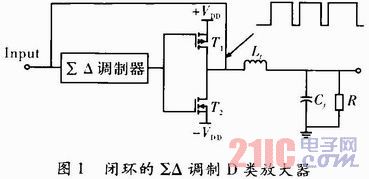
This class D amplifier with negative feedback structure connects the noise and nonlinear distortion of the power output stage to the input of the ∑Δ modulator through feedback to form a closed-loop system, through the noise shaping technique and closed loop of the ∑Δ modulator. The feedback structure achieves the purpose of suppressing noise and distortion at the power output stage.
1 System Modeling In the modeling of the ∑Δ modulation class D amplifier system, it can be considered that the noise and nonlinear distortion of the power output stage are represented by the power output stage noise model shown in Fig. 2. The random noise distribution can be represented by a Gaussian distribution function, and the nonlinear distortion of the output stage can be expressed by the harmonic component at twice the input signal frequency, and the influence of higher harmonic components is not considered here.
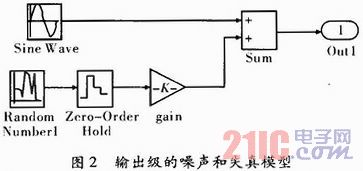
According to the output-level noise and distortion model established above, a non-ideal model of open-loop and closed-loop Class D amplifiers is established in Matlab's Simulink environment, as shown in Figure 3 and Figure 4.
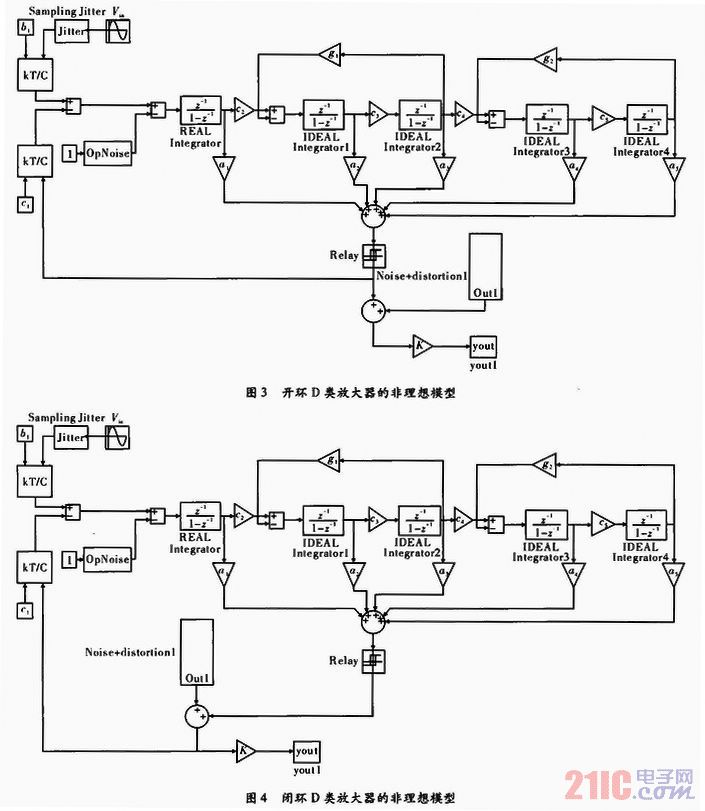
Figure 3 shows the noise and nonlinear distortion model of the output stage when the class D amplifier is added to the output of the non-ideal model of the ∑Δ modulator. The power output stage amplification factor is represented by a gain block K, and the output is an amplified switching signal. . Figure 4 shows the feedback loop of the non-ideal model of the ∑Δ modulator plus the noise and nonlinear distortion model of the output stage. The noise and nonlinear distortion of the output stage are fed back to the input of the ∑Δ modulator through feedback. A closed loop system.
2 Simulation analysis to examine the effect of output stage noise and nonlinear distortion on the performance of closed-loop class D amplifiers. Here, the simulation parameters of ∑Δ modulator: oversampling rate OSR=128, bandwidth BW=25 kHz, sampling points N=65 536 The sampling frequency is Fs=6 400 kHz, the input sine wave frequency is Fin=7 812.5 Hz, and the input sine wave amplitude is 0.487 7 V. Keep the other conditions unchanged, and simulate the relationship between the noise and nonlinear distortion of the power switch output stage and the output signal-to-noise ratio, as shown in Figure 5 and Figure 6.
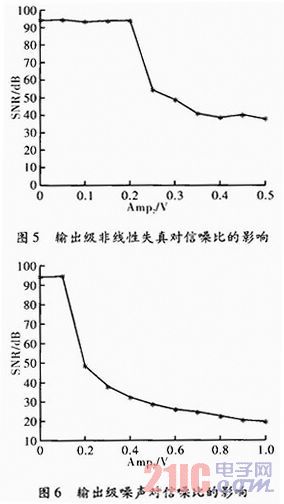
Figure 5 shows that when the amplitude of the first harmonic component at the double signal frequency is <0.2 V, the output signal-to-noise ratio remains above 90 dB. When the amplitude is >0.2 V, the output signal-to-noise ratio drops sharply. The system becomes unstable. Figure 6 shows that the output signal-to-noise ratio is kept above 90 dB when the noise amplitude is less than 0.1 V. When the amplitude is >0.1 V, the output signal-to-noise ratio decreases sharply. Therefore, when noise and nonlinear distortion exceed a certain threshold, the modulator will become unstable, which will seriously affect the performance of the class D amplifier.
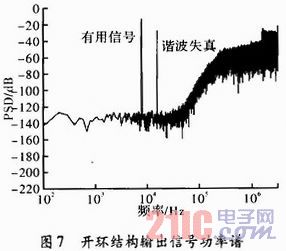
Here, the amplitude of the nonlinear distortion is 0.1 V, and the noise amplitude is 10-6 V. Considering that the noise and nonlinear distortion generally do not exceed the set value of the model in practical applications, the open-loop and closed-loop class D amplifiers are established. The non-ideal model is simulated separately, and the power spectral density of the output signal is shown in Fig. 7 to Fig. 10.
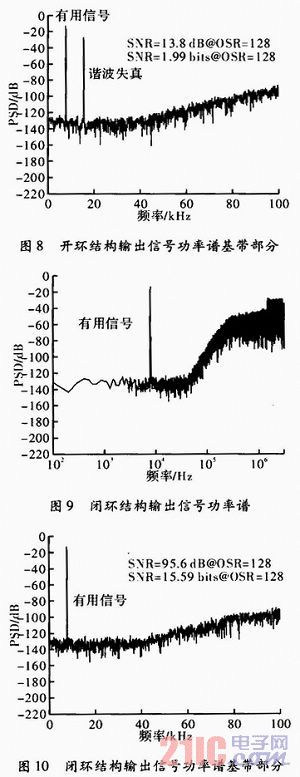
Figure 7 shows the power spectral density of the non-ideal model output signal of the open-loop Class D amplifier. Figure 8 shows the details of the baseband portion of Figure 7. From the figure, the peak of the first harmonic component is -30 dB, if not Suppression will seriously affect the performance of Class D amplifiers. Figure 9 shows the power spectral density of the non-ideal model output signal of the closed-loop class D amplifier. Figure 10 shows the details of the baseband of Figure 9. From the figure, it can be concluded that the first harmonic component of the power output stage is basically suppressed, and the output signal-to-noise ratio is maintained. Above 90 dB, the design requirements are met. At the same time, the output range of the integrator and the input range of the quantizer are both -1 to 1 V. No overload occurs. The stability of the closed-loop Class D amplifier system can be guaranteed. .
3 In the end language, based on a 5th-order low-pass ∑Δ modulator, design a class D amplifier with negative feedback structure, and apply ∑Δ modulation to the class D amplifier for system modeling and simulation analysis. Simulation analysis shows that ∑ △ modulation oversampling technology, noise shaping technology and the negative feedback structure of the closed-loop class D amplifier can effectively suppress the noise and harmonic distortion in the low frequency band. Since the total energy of the power spectrum remains unchanged, only the noise and harmonics of the low frequency band will be The distortion energy is pushed to the high frequency band to achieve a higher signal to noise ratio in the baseband. Applied to audio class D power amplifier, low-pass filter can be used to filter high-frequency harmonic energy, reduce the harm of electromagnetic interference, and effectively improve the electromagnetic interference performance of class D amplifier.
Rental LED Display screens
This series of led display screens can be used in trade shows, concerts, exhibitions, indoor sports events, political rallies, award functions, weddings, even shopping arcades. These LED display screens can be Up and/or Down scaled to fit in any place. The credit goes to their modular design. The astonishing picture quality and clarity of LED display screens brings in visual delight that cannot be missed.
These systems have a strong build, are meant for rugged use and also have a flexible assembly and dismantle. This again makes it quite a popular fit in the broadcast industry. Because of their scalable nature, these LED display screen video walls can be adjusted to fit in a wide range of sizes, character structure and different color options. They can be displayed in varied alternatives like mounted, hanging structure, etc.
Our LED display screen walls are characteristically light in weight with high contrast ratio and high refresh rate. This results in additional flexibility and better visual output without any lag or distortions. For the rental use LED display, flight case, Video Processor, lock button & hanging structure is necessary since the screen needs to move from one site to another very frequently.
Indoor Rental Led Display PR Series
Indoor Rental Led Display Pr Series,Cable Free Rental Led Screen,Indoor Led Rental Display,Indoor Hd Led Screen For Rental
Shenzhen Priva Tech Co., Ltd. , https://www.privaled.com
